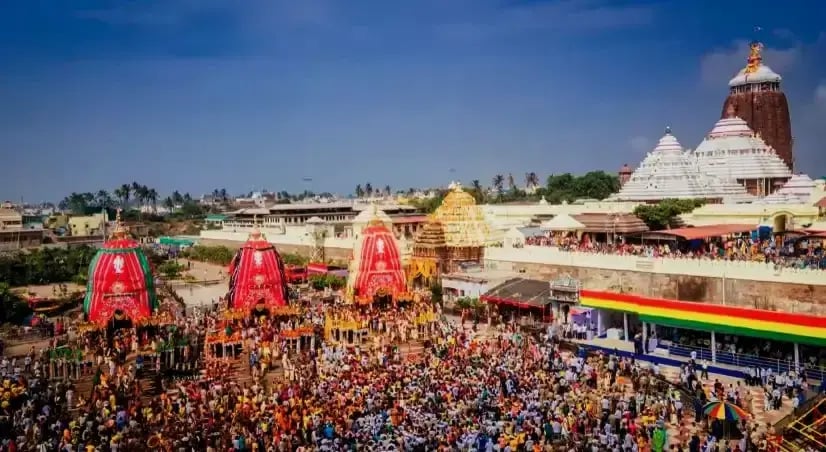Rath Yatra 2025: Significance, History, and Modern-Day Celebrations
Discover the spiritual and cultural significance of Rath Yatra 2025. Explore its history, chariots, traditions, and how modern innovations are reshaping this iconic festival.


Rath Yatra: The Sacred Chariot Festival of Lord Jagannath
Introduction to Rath Yatra
Rath Yatra, meaning "Chariot Festival," is one of India’s most vibrant and spiritually significant festivals, primarily celebrated in Puri, Odisha. Held annually in the month of Ashadha (June–July), the festival marks the grand procession of Lord Jagannath, along with his siblings Lord Balabhadra and Devi Subhadra, as they journey from the Jagannath Temple to the Gundicha Temple, their garden abode.
Deeply rooted in Hindu tradition, Rath Yatra symbolizes Lord Jagannath stepping out of his sanctum to bless his devotees. This divine journey brings the deities closer to the public, emphasizing spiritual accessibility and universal devotion. Millions of devotees gather to witness the spectacle, making it one of the largest religious gatherings in the world.
The vibrantly adorned chariots (Rathas) are meticulously constructed by skilled artisans each year. Pulled by thousands of devotees, the chariots move through the streets of Puri in a magnificent procession, symbolizing a spiritual pilgrimage filled with hope, renewal, and liberation.
Historical Origins of Rath Yatra
The origins of the Rath Yatra date back to the 12th century, with roots intertwined in mythology, history, and religious scriptures such as the Skanda Purana and Brahma Purana. It was formalized under the reign of King Ananga Bhima Deva III of the Eastern Ganga dynasty, who also built the grand Jagannath Temple in Puri.
Archaeological findings and ancient inscriptions reveal that chariot processions may have existed during the Kalinga dynasty, highlighting the festival’s deep cultural roots in Odisha. These ancient rituals were not only religious acts but also expressions of art, architecture, and community life.
Over centuries, Rath Yatra evolved into a monumental spiritual event that resonates with both faith and cultural pride. Understanding its origins helps grasp its significance as a timeless tradition that continues to inspire millions.
The Significance of the Chariots
The highlight of the Rath Yatra is the procession of three colossal chariots, each dedicated to a deity:
Nandighosa – Lord Jagannath’s chariot (approximately 45 feet high)
Taladhwaja – Lord Balabhadra’s chariot
Darpadalan – Devi Subhadra’s chariot
Each chariot is handcrafted using sacred wood from specific trees and decorated with symbolic motifs, vibrant colors, and traditional artwork. The construction begins on Akshaya Tritiya, and artisans follow age-old rituals and blueprints passed down through generations.
Pulling the chariots is not just a ritual—it's an act of devotion. Devotees believe that participating in this sacred task grants spiritual merit and a deeper connection with the divine. The sight of the majestic chariots rolling down the Grand Road (Bada Danda) creates an atmosphere of ecstasy and unity, making it an unforgettable spiritual experience.
Cultural Impact of Rath Yatra
Beyond its religious significance, Rath Yatra is a powerful cultural symbol in Odisha’s identity and India’s rich spiritual heritage. It fosters communal harmony, as people from all walks of life unite in devotion, art, and celebration.
The festival is a hub for traditional arts:
Chariot construction showcases local carpentry and woodcraft.
Folk music and dance, including Gotipua and Odissi, enrich the festivities.
Local artisans display handlooms, paintings, and sculptures inspired by Lord Jagannath.
Rath Yatra has also inspired global cultural representations and art, symbolizing unity in diversity and faith without borders. Its influence extends into literature, music, theatre, and even films, keeping the traditions alive while encouraging creative expression.
Modern-Day Celebrations and Global Reach
While the essence of Rath Yatra remains rooted in tradition, its reach and presentation have evolved dramatically. With advancements in digital media, the festival now has a global audience. Live streams, social media coverage, and virtual tours allow people worldwide to participate in the celebrations.
The Odisha government and local bodies have implemented modern amenities—such as improved sanitation, crowd control systems, and emergency services—to ensure a safe and inclusive experience for pilgrims.
Additionally, eco-conscious initiatives like biodegradable decorations and plastic-free zones are becoming part of the modern-day celebration, promoting sustainable festivity.
The festival’s global reach now includes Rath Yatra celebrations in cities like London, New York, and Sydney, organized by the ISKCON movement, further expanding its cultural influence.
Challenges and Preservation Efforts
Despite its grandeur, Rath Yatra faces several challenges:
Commercialization threatens the spiritual purity of the festival.
Infrastructure strain due to massive footfall.
Environmental concerns due to waste and overuse of resources.
Loss of traditional craftsmanship amid modern construction methods.
To counter these challenges, local communities, cultural institutions, and government bodies are working on:
Heritage education programs for youth.
Grants and recognition for traditional artisans.
Eco-friendly initiatives to reduce the festival's environmental footprint.
Documentation and digital archiving to preserve rituals and oral traditions.
These preservation efforts are vital to retain the festival’s sacred essence while adapting to the demands of modernity.
Looking Ahead: Rath Yatra 2025
Rath Yatra 2025 promises to be a landmark event that blends tradition with innovation. As preparations begin, several enhancements are expected:
Augmented Reality (AR) and Virtual Reality (VR) experiences for virtual pilgrims.
Cultural exhibitions and installations along the chariot route.
International collaborations showcasing Jagannath culture globally.
Enhanced security and crowd management technologies for a safer pilgrimage.
With a focus on inclusivity, sustainability, and technological integration, Rath Yatra 2025 aims to engage younger generations while honoring its time-tested rituals.
Conclusion
Rath Yatra is more than just a religious procession—it is a living embodiment of faith, culture, unity, and heritage. From its mythological roots to modern-day innovations, the festival continues to captivate the hearts of millions. As we approach Rath Yatra 2025, the world prepares once again to witness this majestic celebration of devotion, community, and timeless tradition.
